AMD's Radeon HD 5870: Bringing About the Next Generation Of GPUs
by Ryan Smith on September 23, 2009 9:00 AM EST- Posted in
- GPUs
Eyefinity
Somewhere around 2006 - 2007 ATI was working on the overall specifications for what would eventually turn into the RV870 GPU. These GPUs are designed by combining the views of ATI's engineers with the demands of the developers, end-users and OEMs. In the case of Eyefinity, the initial demand came directly from the OEMs.
ATI was working on the mobile version of its RV870 architecture and realized that it had a number of DisplayPort (DP) outputs at the request of OEMs. The OEMs wanted up to six DP outputs from the GPU, but with only two active at a time. The six came from two for internal panel use (if an OEM wanted to do a dual-monitor notebook, which has happened since), two for external outputs (one DP and one DVI/VGA/HDMI for example), and two for passing through to a docking station. Again, only two had to be active at once so the GPU only had six sets of DP lanes but the display engines to drive two simultaneously.
ATI looked at the effort required to enable all six outputs at the same time and made it so, thus the RV870 GPU can output to a maximum of six displays at the same time. Not all cards support this as you first need to have the requisite number of display outputs on the card itself. The standard Radeon HD 5870 can drive three outputs simultaneously: any combination of the DVI and HDMI ports for up to 2 monitors, and a DisplayPort output independent of DVI/HDMI. Later this year you'll see a version of the card with six mini-DisplayPort outputs for driving six monitors.

It's not just hardware, there's a software component as well. The Radeon HD 5000 series driver allows you to combine all of these display outputs into one single large surface, visible to Windows and your games as a single display with tremendous resolution.
I set up a group of three Dell 24" displays (U2410s). This isn't exactly what Eyefinity was designed for since each display costs $600, but the point is that you could group three $200 1920 x 1080 panels together and potentially have a more immersive gaming experience (for less money) than a single 30" panel.
For our Eyefinity tests I chose to use every single type of output on the card, that's one DVI, one HDMI and one DisplayPort:
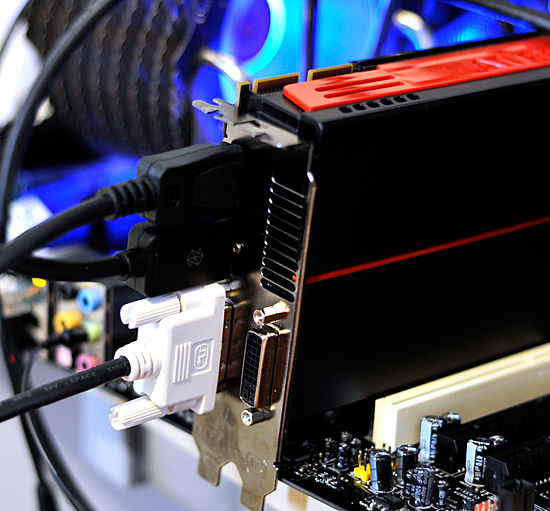
With all three outputs connected, Windows defaults to cloning the display across all monitors. Going into ATI's Catalyst Control Center lets you configure your Eyefinity groups:

With three displays connected I could create a single 1x3 or 3x1 arrangement of displays. I also had the ability to rotate the displays first so they were in portrait mode.

You can create smaller groups, although the ability to do so disappeared after I created my first Eyefinity setup (even after deleting it and trying to recreate it). Once you've selected the type of Eyefinity display you'd like to create, the driver will make a guess as to the arrangement of your panels.

If it guessed correctly, just click Yes and you're good to go. Otherwise ATI has a handy way of determining the location of your monitors:

With the software side taken care of, you now have a Single Large Surface as ATI likes to call it. The display appears as one contiguous panel with a ridiculous resolution to the OS and all applications/games:
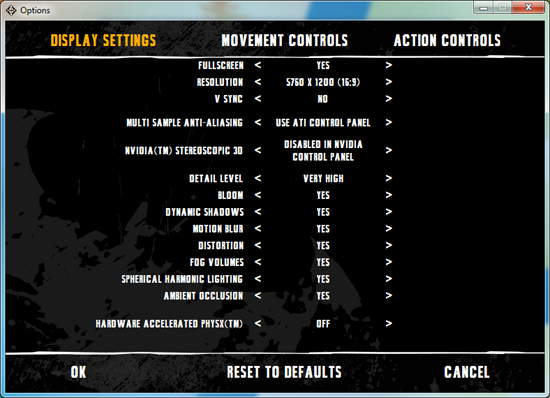
Three 24" panels in a row give us 5760 x 1200
The screenshot above should clue you into the first problem with an Eyefinity setup: aspect ratio. While the Windows desktop simply expands to provide you with more screen real estate, some games may not increase how much you can see - they may just stretch the viewport to fill all of the horizontal resolution. The resolution is correctly listed in Batman Arkham Asylum, but the aspect ratio is not (5760:1200 !~ 16:9). In these situations my Eyefinity setup made me feel downright sick; the weird stretching of characters as they moved towards the outer edges of my vision left me feeling ill.

Dispite Oblivion's support for ultra wide aspect ratio gaming, by default the game stretches to occupy all horizontal resolution
Other games have their own quirks. Resident Evil 5 correctly identified the resolution but appeared to maintain a 16:9 aspect ratio without stretching. In other words, while my display was only 1200 pixels high, the game rendered as if it were 3240 pixels high and only fit what it could onto my screens. This resulted in unusable menus and a game that wasn't actually playable once you got into it.
Games with pre-rendered cutscenes generally don't mesh well with Eyefinity either. In fact, anything that's not rendered on the fly tends to only occupy the middle portion of the screens. Game menus are a perfect example of this:
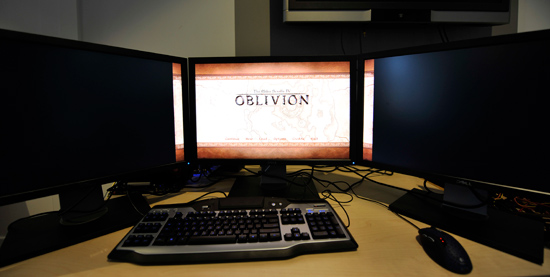
There are other issues with Eyefinity that go beyond just properly taking advantage of the resolution. While the three-monitor setup pictured above is great for games, it's not ideal in Windows. You'd want your main screen to be the one in the center, however since it's a single large display your start menu would actually appear on the leftmost panel. The same applies to games that have a HUD located in the lower left or lower right corners of the display. In Oblivion your health, magic and endurance bars all appear in the lower left, which in the case above means that the far left corner of the left panel is where you have to look for your vitals. Given that each panel is nearly two feet wide, that's a pretty far distance to look.
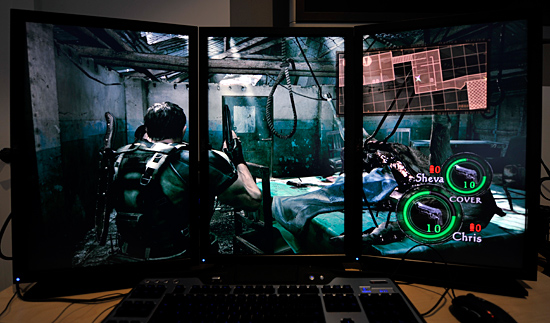
The biggest issue that everyone worried about was bezel thickness hurting the experience. To be honest, bezel thickness was only an issue for me when I oriented the monitors in portrait mode. Sitting close to an array of wide enough panels, the bezel thickness isn't that big of a deal. Which brings me to the next point: immersion.
The game that sold me on Eyefinity was actually one that I don't play: World of Warcraft. The game handled the ultra wide resolution perfectly, it didn't stretch any content, it just expanded my viewport. With the left and right displays tilted inwards slightly, WoW was more immersive. It's not so much that I could see what was going on around me, but that whenever I moved forward I I had the game world in more of my peripheral vision than I usually do. Running through a field felt more like running through a field, since there was more field in my vision. It's the only example where I actually felt like this was the first step towards the holy grail of creating the Holodeck. The effect was pretty impressive, although costly given that I only really attained it in a single game.
Before using Eyefinity for myself I thought I would hate the bezel thickness of the Dell U2410 monitors and I felt that the experience wouldn't be any more engaging. I was wrong on both counts, but I was also wrong to assume that all games would just work perfectly. Out of the four that I tried, only WoW worked flawlessly - the rest either had issues rendering at the unusually wide resolution or simply stretched the content and didn't give me as much additional viewspace to really make the feature useful. Will this all change given that in six months ATI's entire graphics lineup will support three displays? I'd say that's more than likely. The last company to attempt something similar was Matrox and it unfortunately didn't have the graphics horsepower to back it up.
The Radeon HD 5870 itself is fast enough to render many games at 5760 x 1200 even at full detail settings. I managed 48 fps in World of Warcraft and a staggering 66 fps in Batman Arkham Asylum without AA enabled. It's absolutely playable.
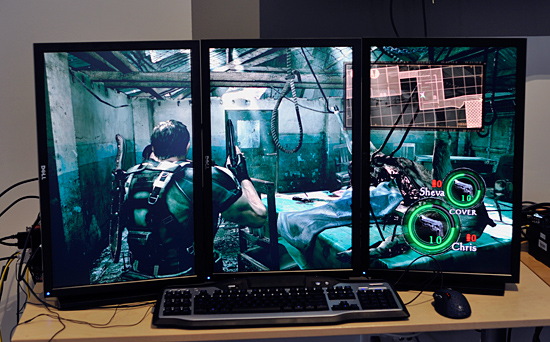










327 Comments
View All Comments
ClownPuncher - Wednesday, September 23, 2009 - link
Absolutely, I can answer that for you.Those 2 "ports" you see are for aesthetic purposes only, the card has a shroud internally so those 2 ports neither intake nor exhaust any air, hot or otherwise.
Ryan Smith - Wednesday, September 23, 2009 - link
ClownPuncher gets a cookie. This is exactly correct; the actual fan shroud is sealed so that air only goes out the front of the card to go outside of the case. The holes do serve a cooling purpose though; allow airflow to help cool the bits of the card that aren't hooked up to the main cooler; various caps and what have you.SiliconDoc - Wednesday, September 23, 2009 - link
Ok good, now we know.So the problem now moves to the tiny 1/2 exhaust port on the back, did you stick your hand there and see how much that is blowing ? Does it whistle through there ? lol
Same amount of air(or a bit less) in half the exit space... that's going to strain the fan and or/reduce flow, no matter what anyone claims to the contrary.
It sure looks like ATI is doing a big favor to aftermarket cooler vendors.
GhandiInstinct - Wednesday, September 23, 2009 - link
Ryan,Developers arent pushing graphics anymore. Its not economnical, PC game supports is slowing down, everything is console now which is DX9. what purpose does this ATI serve with DX11 and all this other technology that won't even make use of games 2 years from now?
Waste of money..
ClownPuncher - Wednesday, September 23, 2009 - link
Clearly he should stop reviewing computer technology like this because people like you are content with gaming on their Wii and iPhone.This message has been brought to you by Sarcasm.
Griswold - Wednesday, September 23, 2009 - link
So you're echoing what nvidia recently said, when they claimed dx11/gaming on the PC isnt all that (anymore)? I guess nvidia can close shop (at least the gaming relevant part of it) now and focus on GPGPU. Why wait for GT300 as a gamer?Oh right, its gonna be blasting past the 5xxx and suddenly dx11 will be the holy grail again... I see how it is.
SiliconDoc - Wednesday, September 23, 2009 - link
rofl- It's great to see red roosters not crowing and hopping around flapping their wings and screaming nvidia is going down.Don't take any of this personal except the compliments, you're doing a fine job.
It's nice to see you doing my usual job, albiet from the other side, so allow me to compliment your fine perceptions. Sweltering smart.
But, now, let's not forget how ambient occlusion got poo-pooed here and shading in the game was said to be "an irritant" when Nvidia cards rendered it with just driver changes for the hardware. lol
Then of course we heard endless crowing about "tesselation" for ati.
Now it's what, SSAA (rebirthed), and Eyefinity, and we'll hear how great it is for some time to come. Let's not forget the endless screeching about how terrible and useless PhysX is by Nvidia, but boy when "open standards" finally gets "Havok and Ati" cranking away, wow the sky is the limit for in game destruction and water movement and shooting and bouncing, and on and on....
Of course it was "Nvidia's fault" that "open havok" didn't happen.
I'm wondering if 30" top resolution will now be "all there is!" for the next month or two until Nvidia comes out with their next generation - because that was quite a trick switching from top rez 30" DOWN to 1920x when Nvidia put out their 2560x GTX275 driver and it whomped Ati's card at 30" 2560x, but switched places at 1920x, which was then of course "the winning rez" since Ati was stuck there.
I could go on but you're probably fuming already and will just make an insult back so let the spam posting IZ2000 or whatever it's name will be this time handle it.
BTW there's a load of bias in the article and I'll be glad to point it out in another post, but the reason the red rooster rooting is not going beyond any sane notion of "truthful" or even truthiness, is because this 5870 Ati card is already percieved as " EPIC FAIL" !
I cannot imagine this is all Ati has, and if it is they are in deep trouble I believe.
I suspect some further releases with more power soon.
Finally - Wednesday, September 23, 2009 - link
Team Green - full foam ahead!*hands over towel*
There you go. Keep on foaming, I'm all amused :)
araczynski - Wednesday, September 23, 2009 - link
is DirectX11 going to be as worthless as 10? in terms of being used in any meaningful way in a meaningful amount of games?my 2 4850's are still keeping me very happy in my 'ancient' E8500.
curious to see how this compares to whatever nvidia rolls out, probably more of the same, better in some, worse in others, bottom line will be the price.... maybe in a year or two i'll build a new system.
of course by that time these'll be worthless too.
SiliconDoc - Wednesday, September 23, 2009 - link
Well it's certainly going to be less useful than PhysX, which is here said to be worthless, but of course DX11 won't get that kind of dissing, at least not for the next two months or so, before NVidia joins in.Since there's only 1 game "kinda ready" with DX11, I suppose all the hype and heady talk will have to wait until... until... uhh.. the 5870's are actually available and not just listed on the egg and tiger.
Here's something else in the article I found so very heartwarming:
---
" Wrapping things up, one of the last GPGPU projects AMD presented at their press event was a GPU implementation of Bullet Physics, an open source physics simulation library. Although they’ll never admit it, AMD is probably getting tired of being beaten over the head by NVIDIA and PhysX; Bullet Physics is AMD’s proof that they can do physics too. "
---
Unfortunately for this place,one of my friends pointed me to this little expose' that show ATI uses NVIDIA CARDS to develope "Bullet Physics" - ROFLMAO
-
" We have seen a presentation where Nvidia claims that Mr. Erwin Coumans, the creator of Bullet Physics Engine, said that he developed Bullet physics on Geforce cards. The bad thing for ATI is that they are betting on this open standard physics tech as the one that they want to accelerate on their GPUs.
"ATI’s Bullet GPU acceleration via Open CL will work with any compliant drivers, we use NVIDIA Geforce cards for our development and even use code from their OpenCL SDK, they are a great technology partner. “ said Erwin.
This means that Bullet physics is being developed on Nvidia Geforce cards even though ATI is supposed to get driver and hardware acceleration for Bullet Physics."
---
rofl - hahahahahha now that takes the cake!
http://www.fudzilla.com/content/view/15642/34/">http://www.fudzilla.com/content/view/15642/34/
--
Boy do we "hate PhysX" as ati fans, but then again... why not use the nvidia PhysX card to whip up some B Physics, folks I couldn't make this stuff up.